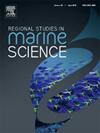Comparative assessment of nutritional quality and ecotoxicological biomarkers in Paphia textile clams from the coastal areas in Egypt
IF 2.4
4区 环境科学与生态学
Q3 ECOLOGY
引用次数: 0
Abstract
Paphia textile, a commercially vital clam species in Egyptian coastal waters, serves as both a nutritional resource and bioindicator of marine pollution. This study evaluates the spatial variability of proximate composition, fatty acid profiles, elemental and heavy metal concentrations (Cu, Zn, Pb, Cd, Hg), oxidative stress biomarkers (SOD, CAT, GPx, MDA, MT), and genotoxicity (comet assay) in P. textile from Ismailia and Alexandria. Clams from Ismailia exhibited superior nutritional value, with higher protein (0.49 ± 0.06 g/g; p < 0.01) and carbohydrate (0.32 ± 0.04 g/g; p < 0.01) content, alongside significant (p < 0.01) elevated antioxidant enzyme activity (SOD: 3.81 ± 0.43 U/mg; CAT: 2.85 ± 0.68 U/mg; GPx: 59.71 ± 5.09 U/mg), reflecting lower environmental stress. In contrast, Alexandria samples showed heightened oxidative damage (p < 0.05), marked by elevated MDA (41.02 ± 2.91 nmol/mg protein), MT (208.42 ± 9.45 µg/g), and significant DNA damage (tail DNA%: 7.8 %; tail moment: 4.8 units). Although health risk indices were below the threshold limit (THQ < 1; TCR < 1 ×10⁻6), heavy metal concentrations, particularly Pb (0.13 ± 0.07 µg/g) and Hg (0.065 ± 0.025 µg/g), were higher in Alexandria highlighting greater dietary hazards despite containing beneficial fatty acids like DHA. Overall, clams from Ismailia demonstrated superior nutritional value and lower health risk, while Alexandria samples reflected greater environmental contamination. These findings highlight the need for continuous environmental monitoring and reinforce Paphia textile as an effective bioindicator for coastal pollution and food safety assessment.
埃及沿海地区帕菲亚纺织蛤营养品质和生态毒理学生物标志物的比较评价
帕菲亚纺织品是埃及沿海水域一种具有重要商业价值的蛤蜊物种,既是营养资源,也是海洋污染的生物指标。本研究评估了Ismailia和Alexandria地区纺织紫草的近似组成、脂肪酸谱、元素和重金属浓度(Cu、Zn、Pb、Cd、Hg)、氧化应激生物标志物(SOD、CAT、GPx、MDA、MT)和遗传毒性(comet assay)的空间变异性。蛤在伊斯梅利亚表现出优越的营养价值,高蛋白质( 0.49±0.06 g / g; p & lt; 0.01)和碳水化合物( 0.32±0.04 g / g; p & lt; 0.01)内容,与显著(p & lt; 0.01)抗氧化剂酶活性升高(SOD: 3.81 ±0.43 U /毫克;猫: 2.85±0.68 U /毫克;GPx: 59.71 ± 5.09 U /毫克),反映出较低的环境压力。相比之下,亚历山大样品显示出更高的氧化损伤(p <; 0.05),其特征是MDA(41.02 ± 2.91 nmol/mg蛋白)升高,MT(208.42 ± 9.45 µg/g)升高,DNA损伤显著(尾DNA%: 7.8 %;尾力矩:4.8单位)。虽然健康风险指数低于阈值(THQ < 1; TCR < 1 ×10 - 6),但重金属浓度,特别是Pb(0.13 ± 0.07 µg/g)和Hg(0.065 ± 0.025 µg/g)在亚历山大市较高,这表明尽管含有DHA等有益脂肪酸,但饮食危害更大。总体而言,来自伊斯梅利亚的蛤蜊表现出更高的营养价值和更低的健康风险,而亚历山大的样本则反映出更大的环境污染。这些发现强调了持续环境监测的必要性,并加强了帕菲亚纺织品作为沿海污染和食品安全评估的有效生物指标的重要性。
本文章由计算机程序翻译,如有差异,请以英文原文为准。
求助全文
约1分钟内获得全文
求助全文
来源期刊

Regional Studies in Marine Science
Agricultural and Biological Sciences-Ecology, Evolution, Behavior and Systematics
CiteScore
3.90
自引率
4.80%
发文量
336
审稿时长
69 days
期刊介绍:
REGIONAL STUDIES IN MARINE SCIENCE will publish scientifically sound papers on regional aspects of maritime and marine resources in estuaries, coastal zones, continental shelf, the seas and oceans.
 求助内容:
求助内容: 应助结果提醒方式:
应助结果提醒方式:


